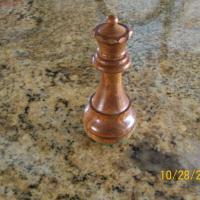
Fixing Chess Pieces that Rattle
Are you embarrassed each time you thump a rook down on the chessboard in a blitz game because the weight inside rattles badly? You are not alone; my own pieces did this very thing for quite some time. Then one day I got motivated and decided to rip into them to see what could be done. The answer was simple, cheap and easy!
Whether your chess set is a cheaper plastic model or made of the most exotic and expensive of woods, if the pieces are heavy and rattle, there is a weight of some sort inside them. Most of the weighted chess sets I have encountered contain small lead weights, but I imagine there are other materials used in some sets.
After I repaired my chess set, it seemed to be of a much higher quality than before, simply because it was quiet! I was so much happier with it because it didn’t rattle horribly, and the players in my club noticed, too. It was substantially cooler to hear a thump rather than a thump-clackity-clack - Well worth the effort.
First, carefully remove the felt from the bottom of the piece. To do this, I used a pocket knife and patience. Of course, if your felt is tore up or dirty beyond belief, this would be a great time to replace it, maybe even with a new color. I recommend doing one piece at a time, so you won’t mix up the felts and weights from other chess pieces.
Once you have the felt removed, turn the piece right side up and the weight will likely fall out, especially if the rattle was real bad. If not, some gentle prodding should get it to come out. Now is also a good time to give the pieces a good cleaning with solvent, since you won’t have to worry about ruining the felt. Glass cleaner works great on plastic sets, and I have used furniture polish on wooden pieces.
Now squirt some clear RTV silicone into the piece where the weight goes. It does not have to be a whole lot; simply fill up a quarter of the space inside the chess piece. Then put the weight back in there and squirt more RTV around it, filling up the rest of the space surrounding the weight. Place a thin layer of the silicone around the rim of the piece and replace the felt; the RTV will stick the felt to the piece. Another benefit to doing it this way is that the pieces will be slightly heavier than before, because of the silicone.
Place the piece upright on a smooth surface such as a counter-top or glass, but not a surface you necessarily care much about, because the silicone will invariably leave marks on it. I used an old piece of cardboard to place mine on while they dried, and it worked very well, but next time I do this I’ll place the piece on something smoother to prevent sticking.
I recommend letting the pieces sit as long as possible before playing with them to ensure that the RTV silicone dries completely. I waited about twelve hours with mine, but five to six hours would probably suffice. You may also want to scrape off the excess silicone, if any exists, with a sharp knife or razor so that the chess piece sits perfectly level on the board.
Now you can slam your pieces down with authority at the club without fear of ridicule or embarrassment. BAM! “Checkmate!”